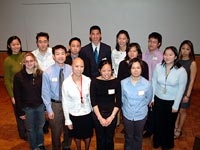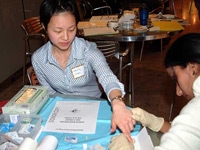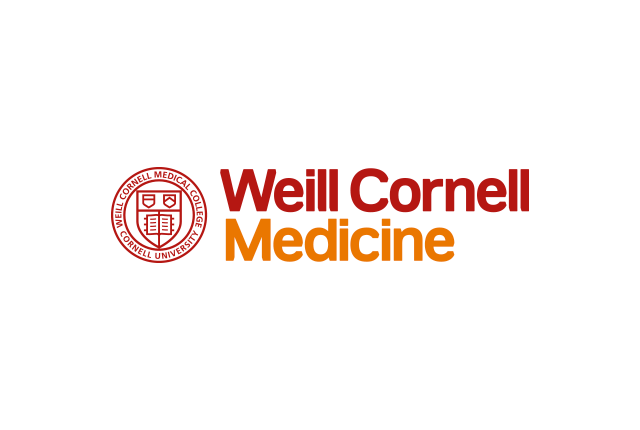
Medical students and event organizers at the APAMSA Northeast Conference were: (Back row) Singyour Li - Weill Cornell, MSI; Jaehon Kim - Weill Cornell, MSI (APAMSA treasurer); Richard Kim - UMDNJ, MSII; Michael Kim - Johns Hopkins Medical College, MSII; Tineke Chan - UMDNJ, MSIII; Eric Yeung - Boston University Medical College, MSII; Vanny Le - UMDNJ, MSII. (Middle row) Jenica Upshaw - Weill Cornell, MSI; Jason Lee - Weill Cornell, MSII (APAMSA co-president); Jennifer Dan - BUMC, MSII; Cindy Ku - Weill Cornell, MSII. (Front row) Carolyn Goh - Weill Cornell, MSII (APAMSA co-president); Lenora Lee - Albert Einstein College of Medicine, MSI; Cindy Hsu - BUMC, MSII.
More than 70 medical students, physicians and community members convened for the Asian Pacific American Medical Students Association (APAMSA) Northeast Regional Conference held March 6 at Weill Cornell Medical College. The goal of this year's symposium, entitled "All Things Taboo: Exposing the Reality Behind the Myths," was to educate medical students about often overlooked issues that affect Asian Pacific American (APA) patient populations.
Represented at the annual regional conference were New England, New York/New Jersey, and the Mid-Atlantic—three of the eight regions that comprise the APAMSA, a national organization made up of 15,000 members. Those in attendance represented 13 medical schools of the Northeast, from as far north as New Hampshire and as far south as Maryland.
The day began at Uris Auditorium with a welcome address by Dr. Judy Tung, assistant professor of medicine at the Medical College and one of the co-founders of the APAMSA, and Dr. Marian Tan Johnson, project director of Children Overcoming Through Resources and Education and mental health initiative director of the Coalition for Asian American Children and Families (CACF), who delivered the keynote address. Dr. Tan Johnson spoke about the myths and realities perpetuated about Asian Pacific Americans, and how the myths can be challenged through education among students, their colleagues and their future patients.
According to Dr. Tan Johnson, one misconception of Asian Americans is the model-minority myth—the idea that most Asian Americans are financially and academically successful. In reality, the APA diaspora represents both the most and least successful of ethnic groups in the United States. Another point that attendees discussed is the often overlooked fact that elderly Asian women have the highest suicide rate among all ethnic groups, occurring nearly three times higher than Caucasian women. Such misunderstandings about who APAs are socially lead to misconceptions about important health issues, such as mental health or sexually transmitted diseases. While HIV/AIDS, for example, is not a statistically major issue among APAs, it is still seen among the APA patient population.
These hidden but growing concerns are one of the reasons those in attendance felt the conference was necessary. Weill Cornell medical student and co-president of the Weill Cornell chapter of the APAMSA Carolyn Goh, '06, believes that as these issues come into light, individuals affected by them will experience less stigmatization. In turn, the issues themselves will less likely be considered "taboo." The open discussion of such topics also helps prepare the students for their roles as future doctors and caregivers, as they may end up treating patients with these very concerns. "It is of benefit for us to address and stimulate discussion of these issues so that we can better attend to the needs of our patients in the future," said Goh.
"By attending the conference, I am now much more comfortable addressing taboo issues such as sex and domestic violence, both on a personal and a professional level, and more convinced of the need for education and publicity on APA issues," said Singyour Li, a first-year Weill Cornell medical student.

A member of the South Asian Marrow Association of Recruiters registers a student for the National Marrow Donor Program by taking a sampling of blood.
Other topics discussed at the conference included APA sexuality, the housing crisis for many Asian and South Asians in New York, meditation and yoga, the need for bone marrow donors, and alternative medicines. Some of the speakers included Dr. Sung Lee, instructor in medicine and medicine in psychiatry at the Medical College; Vandana Chak, director of the Chhaya Community Development Corporation; Dr. Sumon Chin, director of HIV/AIDS Services and Community Services at the Chinese American Planning Council; and Angela Lee, associate director of the New York Asian Women's Center.
Although there exists problems of awareness both within and outside the APA community of the topics discussed at the symposium, those in attendance felt the conference was a step in the right direction. They feel grassroots organizations like the APAMSA and the Coalition for Asian American Children and Families are important tools that function to educate both the APA community and the community at large.
Photos by Amelia Panico.

